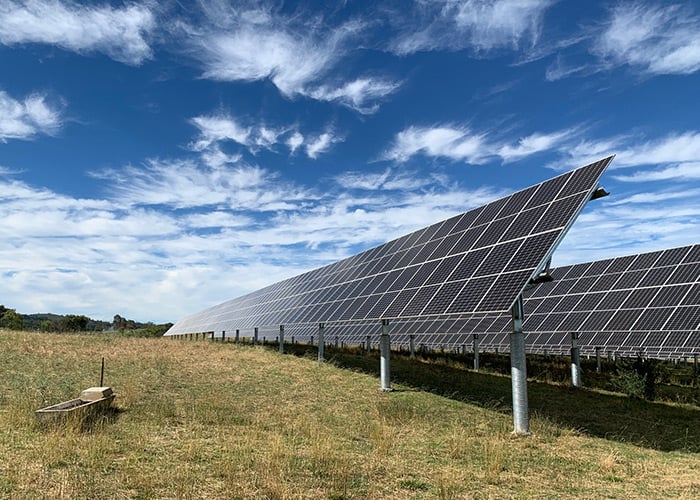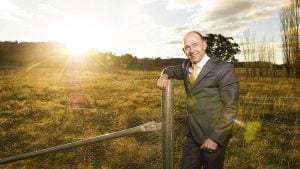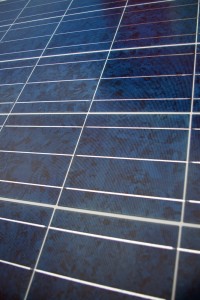Our Flagship Project
We are delivering a 1MW solar project opportunity in the Majura Valley on the outskirts of Canberra. This will be the largest community owned solar facility in Australia and we are very pleased to be able to develop this for the Canberra community.
Quick Statistics
- 5,000 solar modules
- Co-owned by 400 to 600 local community members
- Power for approximately 250 Canberra homes
- 1.8 GWh of electricity each year
- 1600 Tonnes CO2 abatement each year
- 3 hectares
Location
Nestled between the old Majura Rd and the new Majura bypass the site will be on the Majura valley tourism trail and be a part of an area which demonstrates the bush capital vision of Canberra. The area combines local agriculture and produce with nearby institutions like the Winery and Truffle farm and can now boast to being a focal point for local communities transitioning to a renewable future through innovation in sustainability. A map of the proposed site is shown below (click the image for a larger view): We have had some great feedback from community stakeholders in the nearby areas and are very interested in any feedback, questions, queries or comments on this proposal from any member of the community. Please send any feedback to feedback@solarshare.com.au.
Below you’ll find some of our letters of support.
We have had some great feedback from community stakeholders in the nearby areas and are very interested in any feedback, questions, queries or comments on this proposal from any member of the community. Please send any feedback to feedback@solarshare.com.au.
Below you’ll find some of our letters of support.
- Community Power Agency
- Friends of Grasslands
- Friends of Mount Majura
- Molonglo Catchment Group
- Majura Valley Landcare
- Christians for an Ethical Society
- Mount Majura Solar Farm NCA Submission
- Landscape Design Plan
- Striped Legless Lizard Assessment: Mount Majura Solar Farm
- NGH Environmental Assessment
- Mount Majura – NCA – Works Approval
- Mount Majura ACT Heritage – Approval
- Mount Majura – NCA Consultation Report
- Management Recommendations – Extract Report
- Unanticipated discoveries – Extract report
- Epho Environmental Management Plan
- NCA Decision Notice
- Landscaping plan
Funding and Finance
 While it is a sizeable project for the ACT, it will not be the largest by any means.
While it is a sizeable project for the ACT, it will not be the largest by any means.
Technology and equipment
 The solar PV modules are mounted in arrays facing solar North providing maximum capture of the available sunlight. The final selectionPV modules will be made from a short list of top tier brands which includes Trina and Q-Cells. The PV modules are connected to three phase string inverters which deliver an efficiency more than 98% and provide a 10 years product warranty.
The solar PV modules are mounted in arrays facing solar North providing maximum capture of the available sunlight. The final selectionPV modules will be made from a short list of top tier brands which includes Trina and Q-Cells. The PV modules are connected to three phase string inverters which deliver an efficiency more than 98% and provide a 10 years product warranty.
The solar arrays will be mounted on mounting brackets which are positioned into place utilising laser locators to ensure accuracy and correct siting. The mounting system is specially designed for the installation of solar PV modules and supports penetrate the ground to a level of no more than 1600mm reducing the environmental effects of the project and do not require any concrete.
A DC array of 1,260kW has been selected to accompany the 1MW ac generator; this ensures that the full MW of production can be in use for a greater period throughout the day.
The solar PV power generation system will utilise both DC and AC over voltage protection and external surge diverters to protect the equipment against environmental impact and include DC and AC isolators for safe operation and maintenance.
To ensure maximum efficiency and reliability, certified DC and AC cabling will be installed to minimize the power losses and to meet local and national electrical regulations.
A main distribution panel with customer metering, protection relay and monitoring equipment will be installed and will be designed to meet Evo Energy (previously known as ActewAGL Distribution) requirements and regulations. Perimeter protection fencing is proposed with signage and a locked access gate.
Project Risk Management
As with any development that relies on future returns, there is an element of risk in investing in a solar farm. The solar industry has had a history of volatility regarding equipment and subsidy pricing. Equipment prices may vary between project conception and construction, due to global fluctuations in supply or demand of solar equipment or aspects such as exchange rates or other events with unforeseen economic impact. Currently, SolarShare’s officers and board have no reason to believe that such an event is likely to occur. However, due to their very nature, these unforeseen events cannot be predicted with certainty. SolarShare has a board of Directors that maintains and regularly updates the risk register. Our offer Information Statement contain a full description and disclosure of the risks the project may face. We strongly recommend you read this document in full before making a decision to invest. SolarShare’s insurance policy will cover replacement or repair needed due to equipment failures or other events which cause disruption in electricity generation. However, if due to unavoidable circumstances, the generator is out of service for a significant period, it would likely result in a loss of income. For a project selling power through a Feed in Tariff contract, if the Feed in Tariff legislation is repealed then the Feed in Tariff contact with the energy retailer may be revoked. SolarShare believes this to be unlikely, due to the large number of homeowners, businesses and other voters whose income from solar installation on their own private properties would also be reduced if the feed in legislation was repealed.Ready to join?
Get StartedRegister here to become part of Australia’s largest community-owned solar project
Got Questions?
For questions about the Majura project in particular head to our project FAQ page.
Or for more general Q&A click here to visit our general FAQ.
